R2D2 - Dark Roast Edition
by iminthebathroom in Living > Life Hacks
55876 Views, 145 Favorites, 0 Comments
R2D2 - Dark Roast Edition
.JPG)


.JPG)
.JPG)
.JPG)
.JPG)
This instructable is finally complete with the now missing steps. The Dome and torso section coverage were a little sketchy the first time around as one of my SD cards went missing. It was since found when tearing out some floor molding in the kitchen. Geez, why do I never look in the obvious places... So now their is no excuse to build one of these. While your at it, load up on some Star Wars Vader's Dark Side Roast Coffee from ThinkGeek and this project will be complete
Star Wars, Love it or hate it. One thing you can’t deny is the universal love and identification of one of its side characters R2D2, the little astromech droid who could. Only now, he even better… cause he makes me coffee. Of course anyone who makes me coffee goes up a few notches, so why not have a world renowned icon make it for you. And for the tea drinkers, well… I guess you could use it to brew tea, if you like that sort of thing, probably while you watch Star Trek Deep Space Nine…
In my world, Darth Vader doesn’t go all soft in the end. Instead of taking off Luke Skywalkers hand he takes off his head, the rebel alliance is quashed, ewoks are served up crispy fried on a stick and Darth takes R2D2 as his trophy trinket, turning him into his morning caffeine delivery device. AKA R2D2 Dark Roast Edition.
Betcha Yoda didn’t see that coming, huh George Lucas
Thank you all who have posted all the great comments! It was a great build!
WARNING – UBER LOOSEY GOOSEY SCIENCE PART
So the whole concept behind this was to have a coffee maker that could be used to brew coffee quickly for larger dinner parties that we have from time to time. A regular coffee pot is just too slow to brew pot after pot as its being emptied so quickly by caffeine crazed guests. Enter the industrial BUNN type coffee maker. It uses a tank of water that holds two coffee pots worth. First you pour in two coffee pots worth of water and turn the unit on. It takes about 5 minutes to get the water hot the first time around, then it waits for you to add one more pot of cold water, this is when the magic begins. As you pour cold water into the hopper tank, it descends a down a tube to the bottom of the heated tank. Now this tank all ready has water in it that is nice and hot. The cold water which naturally wants to stay on the bottom anyway pushes the heated water up and out an overflow at the top of the tank. This overflow is connected to a tube which has its end set just below the level at which the hot and cold water find a balance. As water flows out the tube it creates a siphon effect draining out the hot water from the reserve tank and allowing space for the cold water in the hopper to fill up. Now the hot water has to go somewhere, so why not channel it into a coffee ground hopper where it brews up a tasty and oh-so quick pot of coffee. The BUNN coffee units spout is kinda like one of those rain shower heads, where it sprinkles down hot water over all the coffee ground area at once. This wets out the grinds quickly allowing for a quick brew. Regular home units trickle it out at insanely slow speeds often inducing madness in morning commuters and small dogs alike. Finally the large heater element takes very little time to heat up the now cold water in the tank and by the time you have drained the first pot of coffee, and gotten new coffee grinds ready the cycle is ready to start anew, remembering the tank holds two pots worth of hot water so is all ready ahead by one pot.
Design

When building your R2D2 coffee maker there are several important thoughts to consider, with two of them being vital.
First would be the dome, this has got to be the hardest part to find. You wouldn’t think finding a perfect half dome wouldn’t be that hard, but it is, at least for someone as rural as myself. Whenever I build something I always try and use recycled bits and pieces to keep my costs down and help the environment. After all, every dome that is recycled rather than store purchased means one less innocent dome is hunted down and slaughtered. That and I’d rather spend the money on my wife and kids then into give it to some middleman dome pusher. People have tried using all sorts of things from salad bowls to cake moulds. The life sized R2 makers typically use a bird bath that was produced for a period of time, evidently these have stopped being in production. I found a industrial stainless steel float valve that was actually a perfect sphere at the local dump. I was able to cut in half giving me two domes. What you really want however is a dome that has about an extra inch at the edge like the real life production model had. Mine is faked a little with the paint scheme disguising it. The second dome was used to make the top water door and the central eye piece and made the build a lot easier. So if you can get two identical domes, do it. Now the size of the dome directly plays off the next crucial design step.
The BUNN coffee tank – really my dome should have been 3-4 inches larger to keep the aspect ratio of R2D2 true to life. Once again I have disguised it by building a base on it that is cantilevered between the legs. Another visual distraction is the Barista apron.
Other thoughts are things like
What material are you, or can you use? I can weld and cut steel and stainless steel, so this is my primary choice of material used. If I had the means to weld aluminum who knows... As is I ended up using a variety of metals from steel, stainless steel, aluminum, copper and even some brass. Of course I don’t have the means to perform mythical metallurgical welding so I had to mix it up a bit. A little welding, some brazing, soldering and some epoxy to round it out. With all these types of joining you really want your materials to fit tightly together for good strong bonds.
Electricity – you really should have a basic concept of what you’re doing otherwise you could fry yourself or someone else down the road. When you are not sure, make damn positive you talk to someone who does.
Safety
Cutting, welding, brazing, soldering and gluing metal is very hazardous. It will cut you, burn you, electrocute you and finish off by poisoning you. You’ve been warned, take precautions
After that everything else is pretty much for kicks, like making him talk, adding lights and other finishing touches. Details are important, but remember this is still a coffee maker that you or someone else has to clean. All those little nook and cranny details are suddenly not so cool when you have to clean it!
Supplies

“Keep in mind that aside from welding wire, epoxies, paint and the recordable greeting card everything was from the dump. Even the BUNN coffee maker was rescued from a building due for demolition” Which bring me to the bleeding hand photo, Just cause its second hand doesn't make it safe.
Stainless steel sphere cut into 2 domes
Stainless steel plate 1/8” thick about 6 square feet
Stainless steel stove pipe tube “body”
Stainless Steel perforated sheet “barista apron”
Stainless Steel cantruss “electrical cable tray building material”
Small stainless steel hinge
Hollow copper float ball
Working but perhaps underappreciated BUNN industrial tank style coffee maker
Wire for connections
LED’s/resistors and a means to light them, i.e. small transformer. LED’s were from automotive gadgets and an old cell phone charger
Various bits of “what have you” to make the details with, i.e. holo projector lens, coffee grind droids eyes etc...
2 liter pop bottle – empty
Quick set epoxy – clear
Aquarium grade silicone caulk
Switch and or lights you wish to use to replace the standard one off the BUNN unit
Recordable greeting card and a momentary switch to activate it
Durable paints
Tools used
Lots and lots of clamps
Angle grinder with flap discs and zip-cut abrasive discs
MIG Welder, brazing tools, soldering tools
Safety equipment and the knowledge to use it
Dremel with various bits
And a wide assortment of hand tools such as files, screwdrivers, paint brushes etc...
Band-aids, polysporin and a tetanus shot might not be a bad idea.
Bunn Break Down
.JPG)
.JPG)
.JPG)
.JPG)
.JPG)
.JPG)
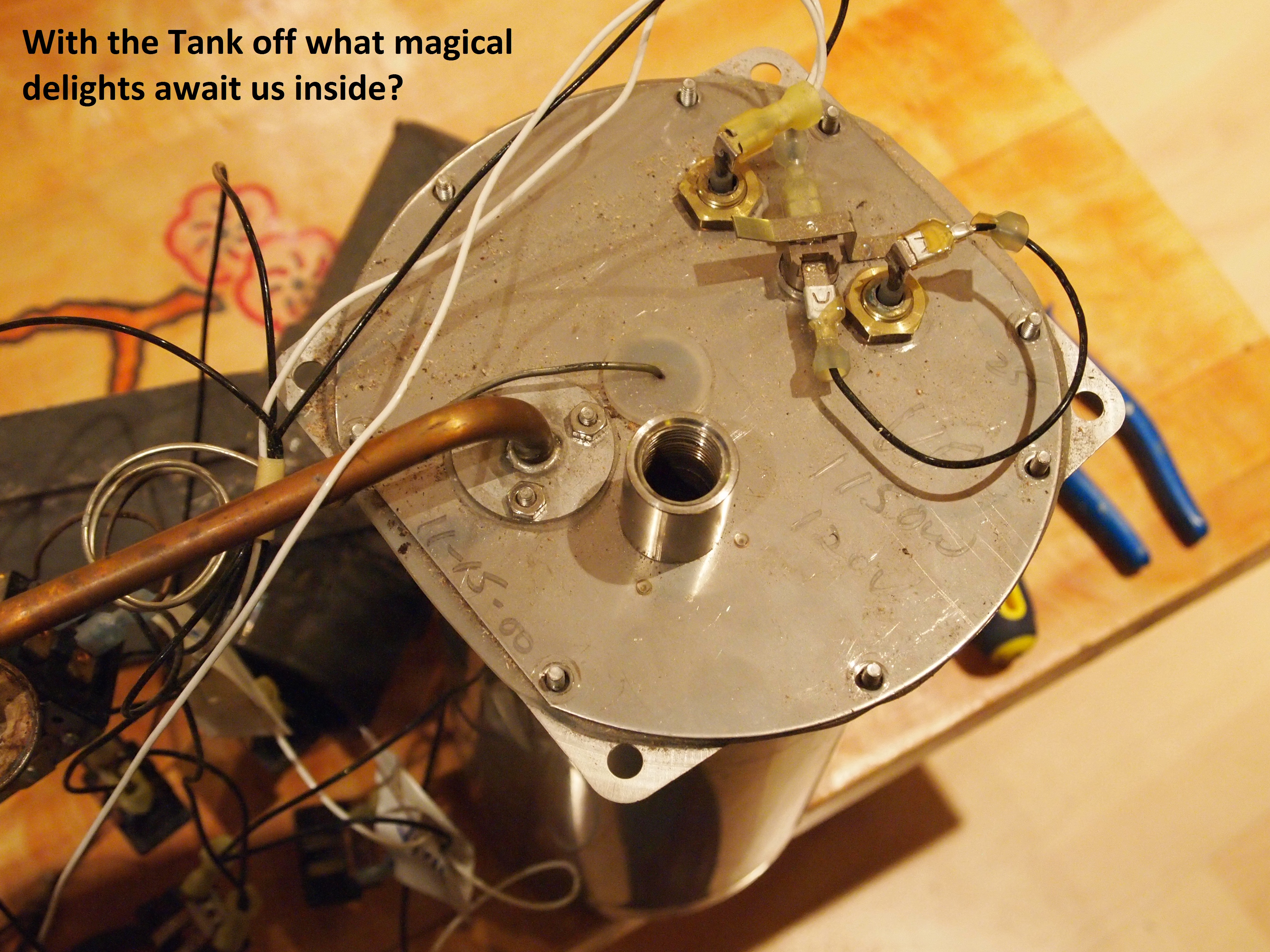.JPG)
.JPG)
.JPG)
.JPG)
In the end you should only be left with the reserve tank, the top receiving tank, the down spout, controls and wiring. Key to this build is to keep an eye on the wiring. It would be very easy to disconnect wires will-nilly and forget how they hook up again.
Dome
.JPG)
.JPG)
.JPG)
.JPG)
.JPG)
.JPG)
.JPG)
.JPG)
.JPG)
.JPG)
.JPG)
.JPG)
.JPG)
.JPG)
.JPG)
.JPG)
.JPG)
.JPG)
Now normally I would be providing you with tons-o-pictures of this step, but I misplaced my brand new shiny 16gb, class 10 SD card with a gazillion photos on it, the horror. Suffice to say you will all have to deal with my sketchy descriptions.
Have your dome marked out, and cut it in half. I just followed the weld lines from when it was originally put together.
Cut out a disk to fit in the bottom of the dome from your plate steel, creating your new tank. The disc should slip inside the dome by about ¾ of an inch. Don’t attach it yet.
Mark off where you want your hole for the water to be poured in and cut it out. Really the size should allow quick easy pouring yet at the same time you don’t want it to huge. From the other half of the dome cut out a suitable sized lid to cover the water entry hole by about ½ inch on all sides. Fit the lid on top of the dome covering the hole and line up where the hinge should go – mark it. Take apart the hinge and weld one section onto the door and one onto the dome.
Get your round plate you cut for the bottom of the tank and place it over the bolt hole for the BUNN tank. Mark its location and drill a hole just ever so wide enough to allow the brass locking bolt to fit through. This will lock the dome and the tank together in the end, so take your time. The tank should be below the disc centered with the hole off centered by a couple inches.
Flip the dome over and insert the dome bottom “the one you just drilled”, it should fit into the dome by about ¾ of an inch. Weld a continuous seam all the way around attempting to make it water proof. Will caulk it later just to be sure but try your best anyway.
Next cut a 1 ½ inch strip of thin steel the diameter of the dome inside bottom. Attach as you see fit, for some reason I riveted it in, I could have welded it though, oh well...
Going back to the scrap dome, drill out a hole the size you want the large black center lens to be. Then cut out the triangle shape around it. Drill 2 holes through the triangle shape and plug weld it to the top dome where you think it looks best. For the actual black lens, you are going to use a trick I learned on one of the astro-droid websites. See the finishing section at the end for directions. Remember were looking for the best interpretation of R2D2 as a coffee maker, not a museum quality copy. Assemble your various lens holders and weld or glue them on. Mine were made of brass and aluminum which you can’t weld, and just epoxy seemed sketchy. My solution was to hold the hollow tubes against the dome where I wanted them to be. Then using my welder put tack welds on the inside where the brass meets the stainless steel. Though this doesn’t weld it together, it does weld the tack to the dome. The molten metal melts out a small section of the brass or aluminum and the steel pours in. This locks it tight to the dome. It also provides a lot of irregular surfaces for the epoxy to mechanically join to. Which is what I did next, put in a heaping dollop of quick set epoxy. The pokier lens needed something special, so before filling it with epoxy I drilled a hole down the center right through the dome and out the bottom. I then put some automotive LED’s in the bottom feeding the wires through to be hooked up later. The I simply filled the entire lens with clear epoxy. This sealed the bottom hole and locks the leds in place. It also looks like a lens. Later will hook it the wires. In the event the led’s burn out, simply drill out the epoxy and LED’s all together and feed in new ones followed by fresh epoxy – easy!
Mark off the dome and tape it off. Razor trim out the sections you want painted and peel the tape off. Paint 3 light coats of anodize-it blue paint and allow to set. Quickly and gently remove the tape. Touch up where ever paint was peeled off with the tape. Anodize-it paint looks great but is a little weak being a lacquer. Paint over with clear enamel hard coat.
Make sure to study the pictures, I’ll try to add more that hopefully explain it better, really need to find that SD card, damn gremlins.
Body
.JPG)
.JPG)

The first method I tried was using stainless sheet metal that I would wrap around a plywood frame I built for this purpose. It just never looked right by the time I was done. Partially because the steel I was using was designed to lay flat, It had never been machine rolled. So I went the semi easy route. I used a section of stainless steel stove pipe. This was the kind that you assemble with an interlocking flange. Though not quite large enough to use for the entire diameter, it was easy enough to modify to make larger. First I traced the dome onto a sheet of plate steel. Then I cut a 1 inch ring around it. I then cut thin pie sections all along the outer ring, going to the center ring. This creates tabs which you bend up. Create your tube by bending the stove pipe around the flange on R2’s dome. Lock in place just at the dome with some duct tape. Then insert the plate in the bottom and tighten the stove pipe around it. Drill and rivet the stove pipe in at least 4 places and remove the tape. It should now be locked together. Remove the dome and start drilling through the base of the tube into the tabs on the bottom plate. Rivet or weld in place. If your tube is larger then mine you should be able to fit everything in the tube. Mine just didn’t have space for the thermostat switch so I made a small box which protrudes from the back. Again the sizes will need to be determined by you, my dome should have been wider then it was, so my proportions are skewed a little. Ah well, such is life.
Shoulders and Legs
.JPG)
.JPG)
.JPG)
.JPG)
.JPG)
.JPG)
.JPG)
.JPG)
.JPG)
.JPG)
.JPG)
.JPG)
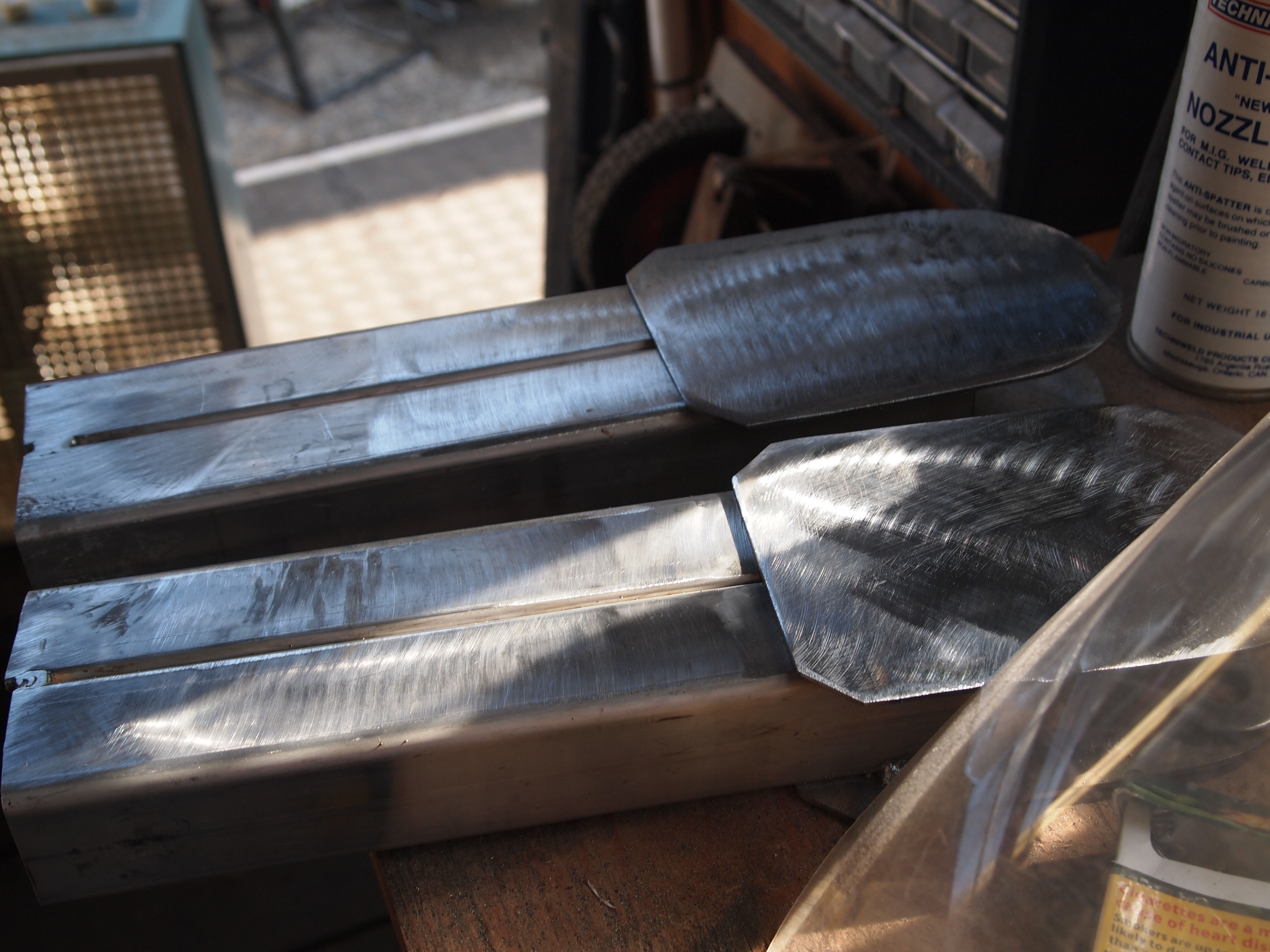.JPG)
.JPG)
.JPG)
.JPG)
.JPG)
.JPG)
.JPG)
.JPG)
.JPG)
.JPG)
.JPG)
.JPG)
.JPG)
.JPG)
.JPG)
.JPG)
.JPG)
(Cantruss or Uni-strut is a type of U-Channel used in industrial settings for building structures and supporting things like gas lines or heavy duty cables.)
I cut two sections of cantruss and welded them together open point to open point. This created a nice thick bar. The legs were left extra long as they could be trimmed later. Looking at pictures on the net I drew up some plans using a combination of GIMP open source software and the free version of Inkscape to convert it to a vector image. From this I printed up the size I wanted and traced the perimeter of the shoulder. I then cut 4 of these out of my plate and welded one to the face of the leg and one to the back from inside. Always clamp items together when welding otherwise things tend to move around when charged with electricity.
Next I cut a long piece of steel to span the gap going all around the shoulder. I tack welded the starting point and chucked it in my clamp. Allowing a long span of steel allows easy bends. As I bent it around the shoulder I would tack weld it in place, often with the use of clamps for positioning. The Strip was deliberately cut wider then needed. This way when you weld, the edge melts in to the weld give a stronger joint. The excess is just ground off in the finishing process.
Oh-yeah, grind it off till smooth = finishing process
Feet
.JPG)
.JPG)
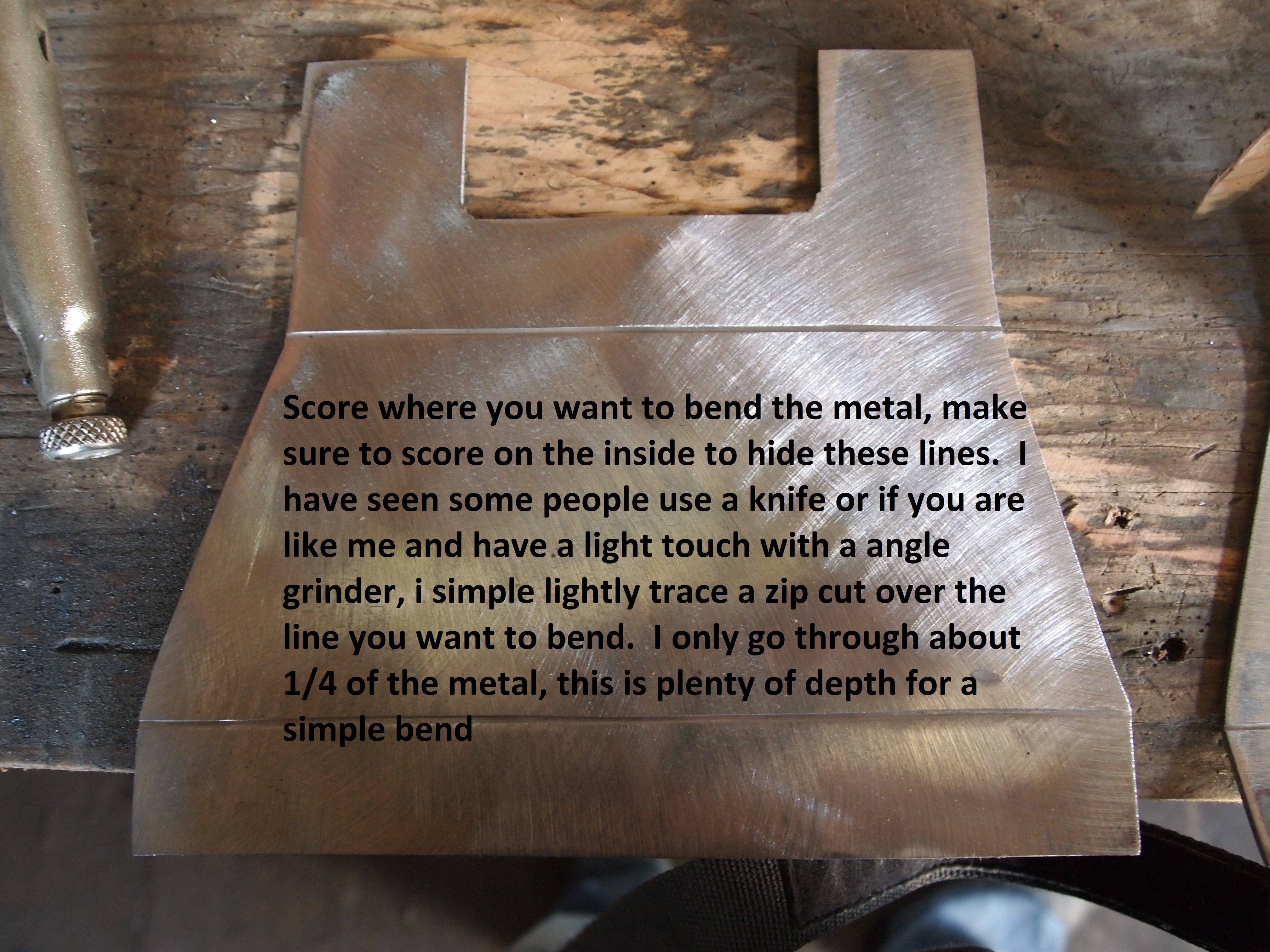.JPG)
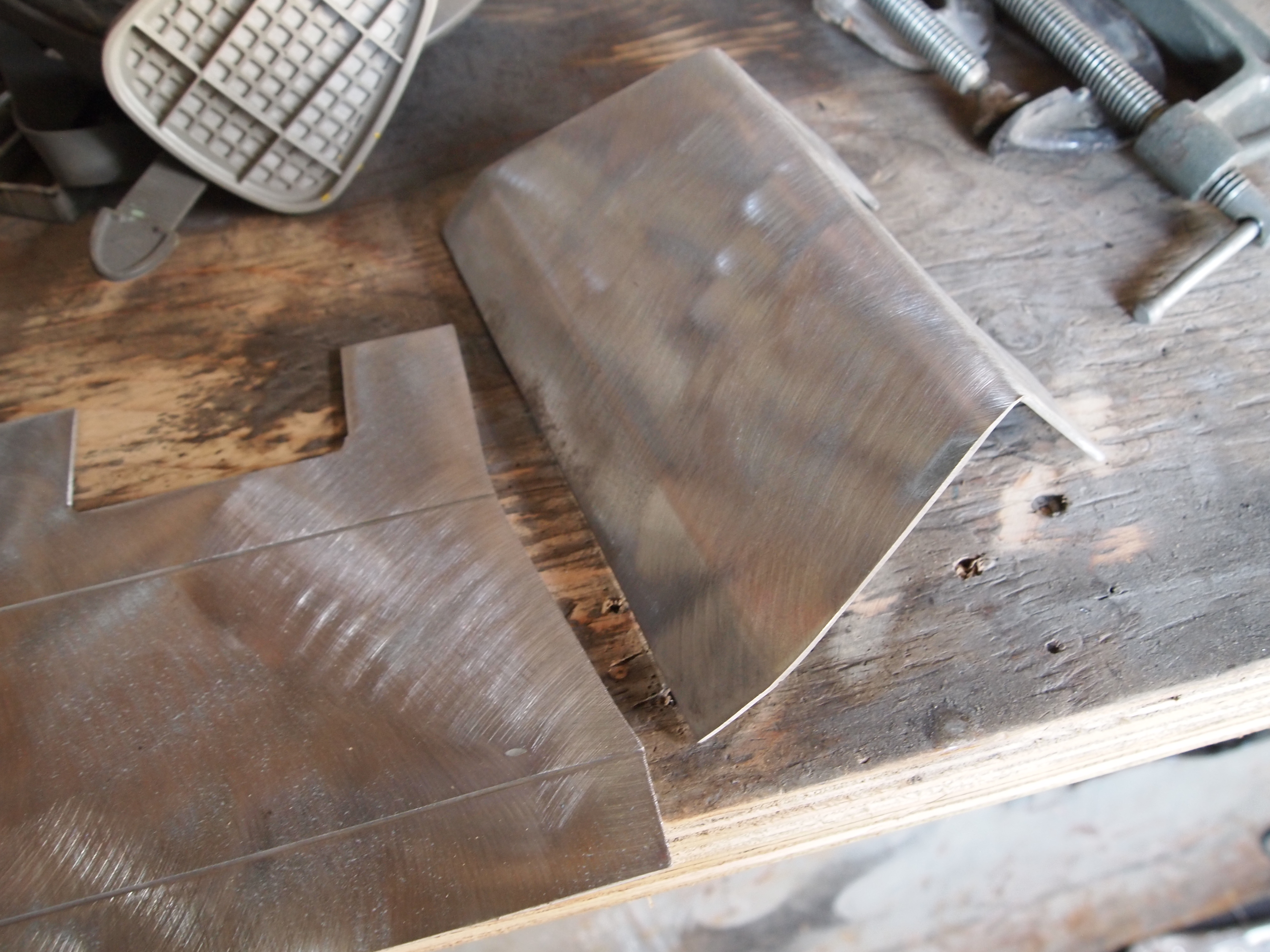.JPG)
.JPG)
.JPG)
.JPG)
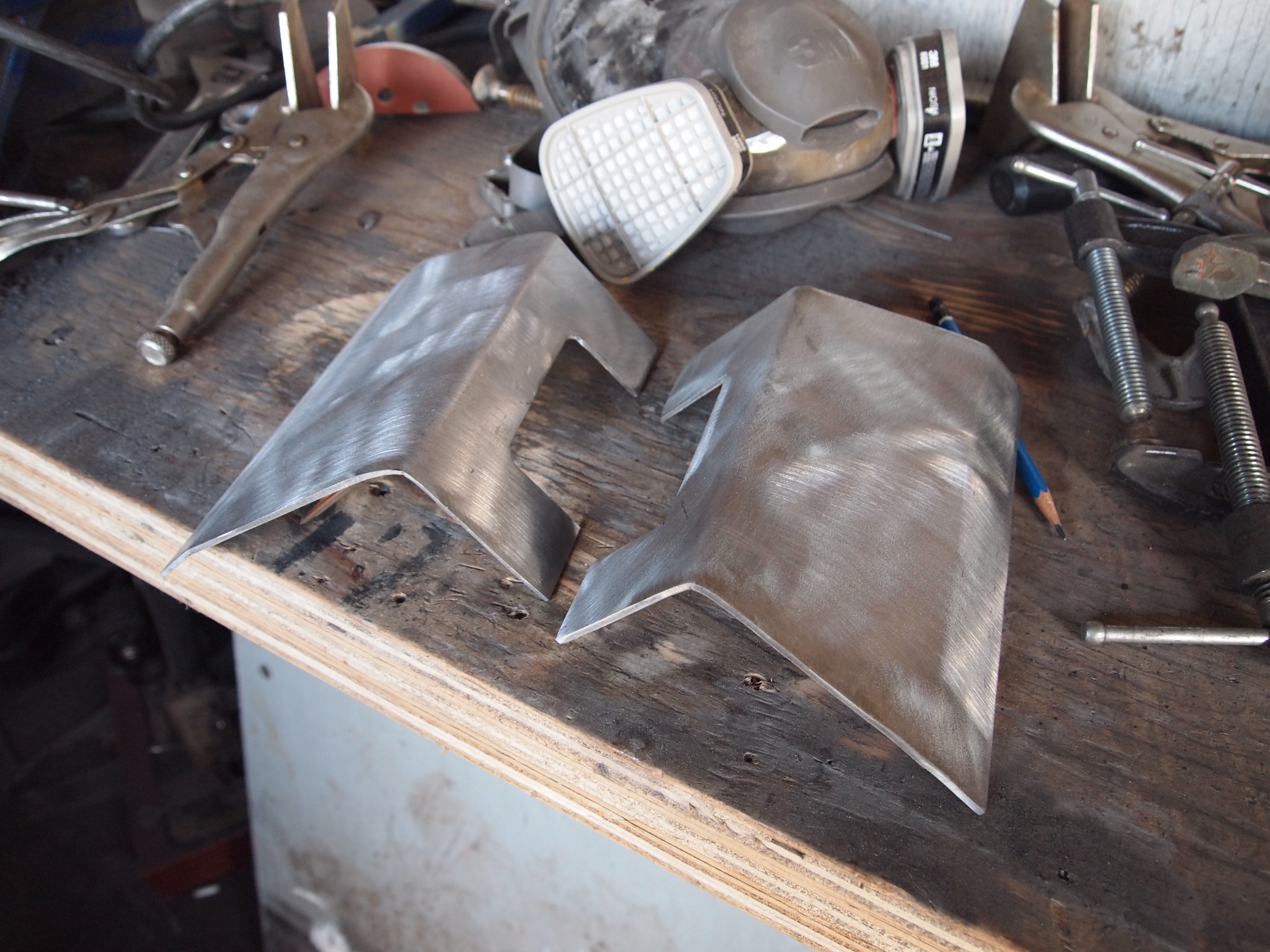.JPG)
.JPG)
.JPG)
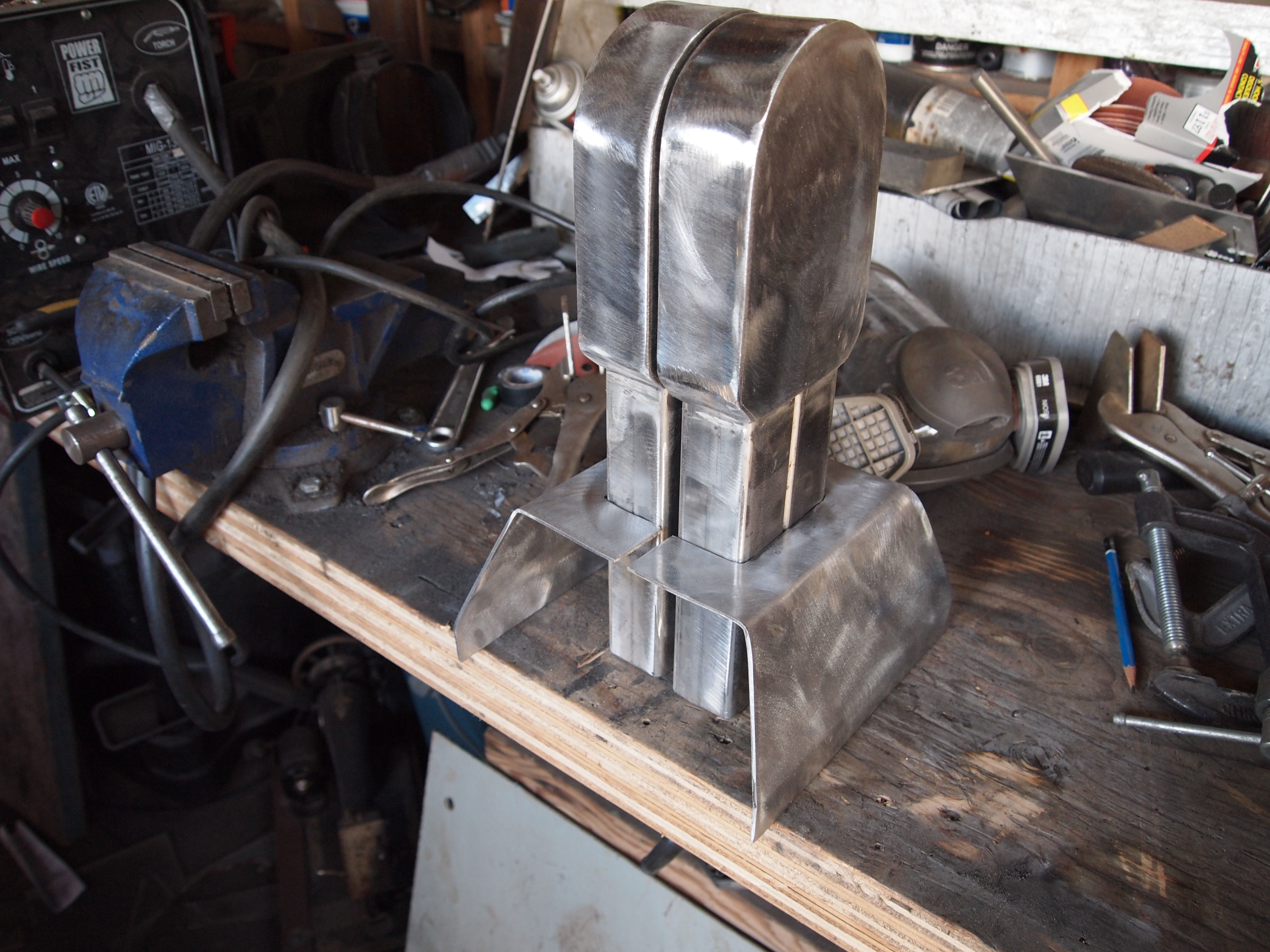.JPG)
.JPG)
.JPG)
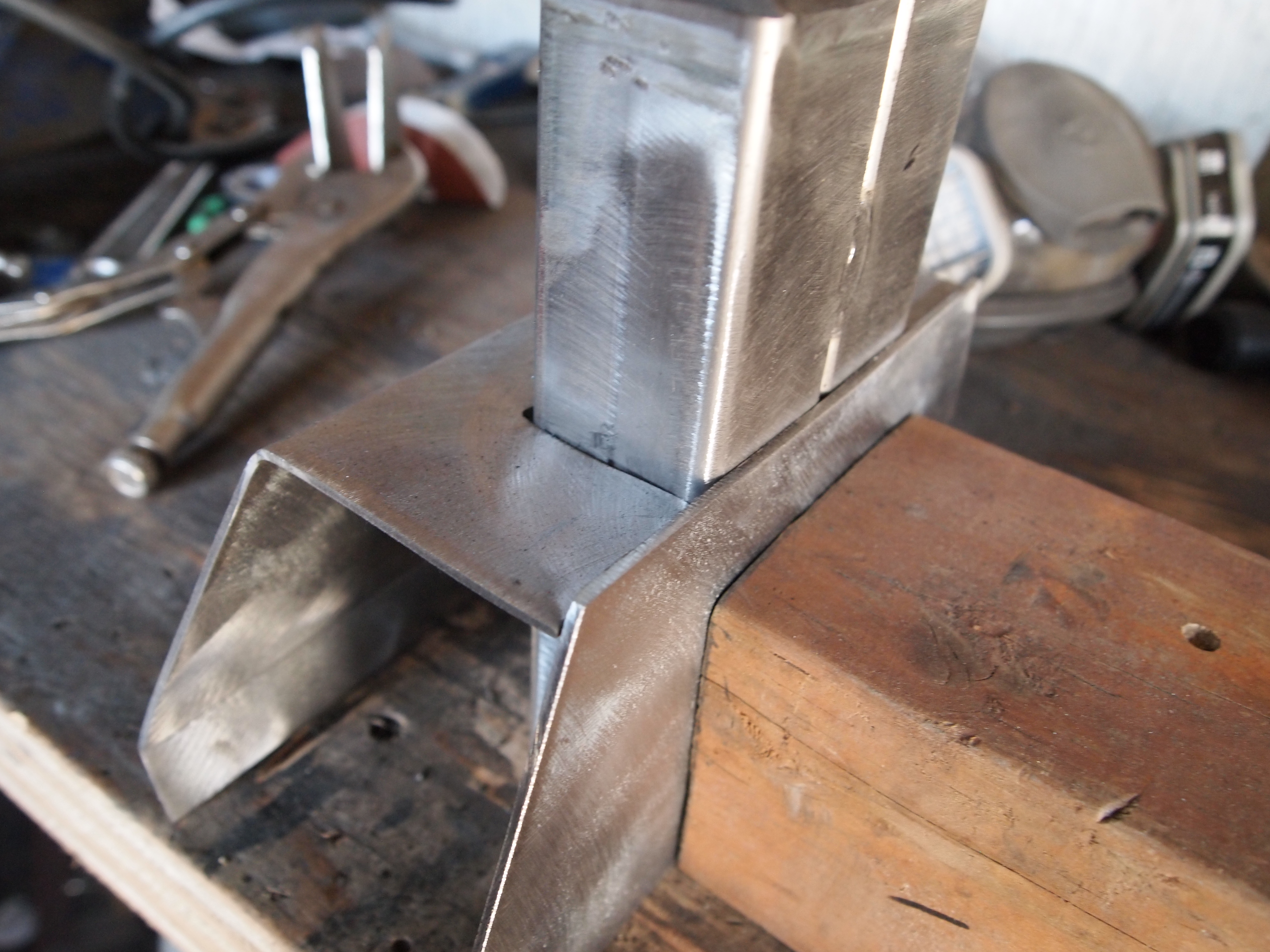.JPG)
.JPG)
.JPG)
.JPG)
.JPG)
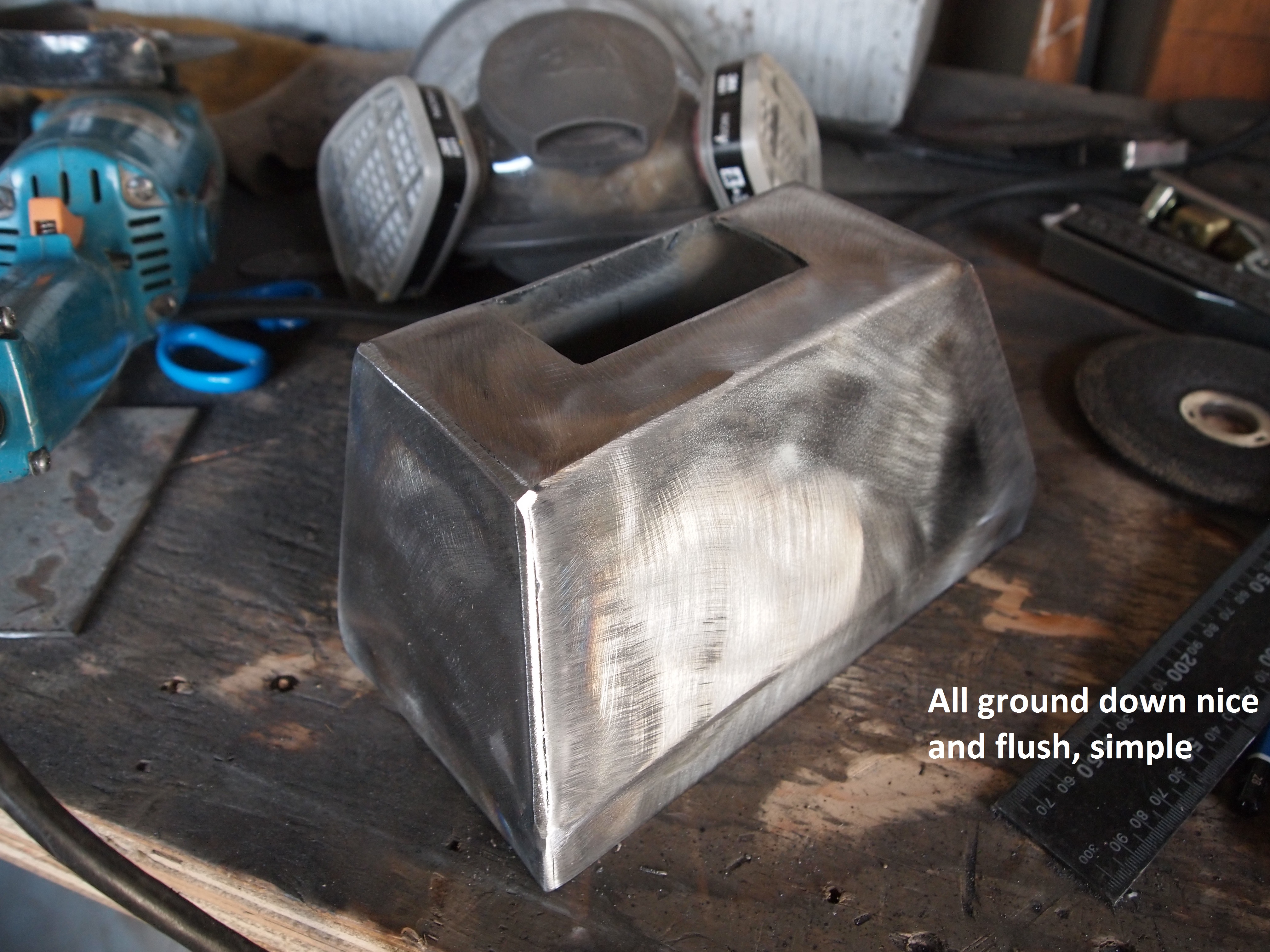.JPG)
.JPG)
.JPG)
.JPG)
.JPG)
Base
.JPG)
.JPG)
.JPG)
.JPG)
.JPG)
.JPG)
.JPG)
.JPG)
.JPG)
.JPG)
.JPG)
.JPG)
.JPG)
.JPG)
First I cut a bottom plate that would contain R2’s body and span a large enough gap to hold the coffee pot warmer directly under the hot water spigot. Then I simply placed the body and coffee warmer plate on the lower base plate where they should be and trace around them. Next I used the lower plate to trace another tray and cut this one out as well. The it was a simple manner of cutting out where the body and warmer plate was to be put out of one of them.
Here is a trick when cutting a tight radius in plate with a zip cut disk. Cut only halfway through along your cut line. If you try to cut all the way through either you’ll widen the cut line too much or the blade will probably shatter send bits of abrasive disk into you or anything else around you. This can be deadly, always use a full face shield and very heavy clothes that are tightly fit, no baggy clothes here! But I digress; now flip your plate over. The heat generated by cutting through halfway will have made a perfect pattern line on the reverse side. Just finish cutting through and you’re good to go, this makes tricky two sided lay outs easy!
Next I took two one inch thick pieces of square tube steel and sandwich welded them between. Just like the shoulders I cut a long strip of steel to bend around it. Just like before, weld at the start and then slowly bend it around welding as you go.
Grind off excess and check your welds. Seeing a seam on the feet or shoulders is fine, but on the top plate you really want it took like one massive piece of steel. Plus coffee dribbles will get in there and make a mess! Darth would not be pleased. A clean Empire is a productive Empire, as Darth always used to say.
Next weld the feet to the base from the bottom and inside where possible. These welds will be very hard to grind down, so do where it’s the least obvious.
Coffee Holder
.JPG)
.JPG)
.JPG)
.JPG)
.JPG)
.JPG)
.JPG)
.JPG)
.JPG)
.JPG)
.JPG)
.JPG)
.JPG)
.JPG)
.JPG)
.JPG)
.JPG)
.JPG)
.JPG)
.JPG)
.JPG)

Cut out 4 chevrons. One will be decorative on top, the other three will be used as an attachment device for the hopper holder.
The first two were bent to fit the curve of the body, not an easy thingy to do with steel this thick, but manageable. Drill a hole in either end of the these two chevrons and then hold it against the body where you want it to go. Mark the holes on the body and drill out. Later these will be used to bolt the chevron/coffee ground hopper to the chest. “The top chevron I actually fed the bolts through the holes, sanded the heads down next to nothing and welded them in place. This looks great but is tricky getting it back on the body because of the curve!”
The other two were given a mild bend, to look like they were on hinges that sprung from the chest. These were welded to the cross piece chevron. As the connection point was quite small I welded in corner braces to make it strong.
I rolled a ring of steel around my globe coffee hopper and tack welded the ring together. Check to make sure it still fits and lightly tack weld it between the two outstretched chevrons. Check the alignment and fit again by holding against the unit. Once you are happy weld it all together nice and tight. Grind smooth.
The coffee hopper went through dozens of design iterations. I hummed and hawed over what it should look like. For a while it was going to be a droid with antennas and tons of detail. Then I couldn’t decide to make it comedic or scary looking. Next I was toying with the idea of making it look like the light sabre practice ball Luke first uses on the Millennium Falcon, but eventually decided on keeping it ultra simple, with 3 ruby red eyes set in hand milled brass. It’s almost insect like in nature in appearance, not really caring whether it’s viewed as cute or creepy. Basic construction was to cut out a quarter section of the sphere, this allows the coffee grounds and filter to slip out easily enough. Holes for the 3 eyes were drilled out with a step bit and the eyes wedged in place. Inside the copper had been etched to give it some tooth around the eyes and a puddle of epoxy drizzled in. Guess this could have been brazed or even soldered in place but the glass used in the eyes is sensitive to those kinda heat levels.
Talk Like a Good Little Robot
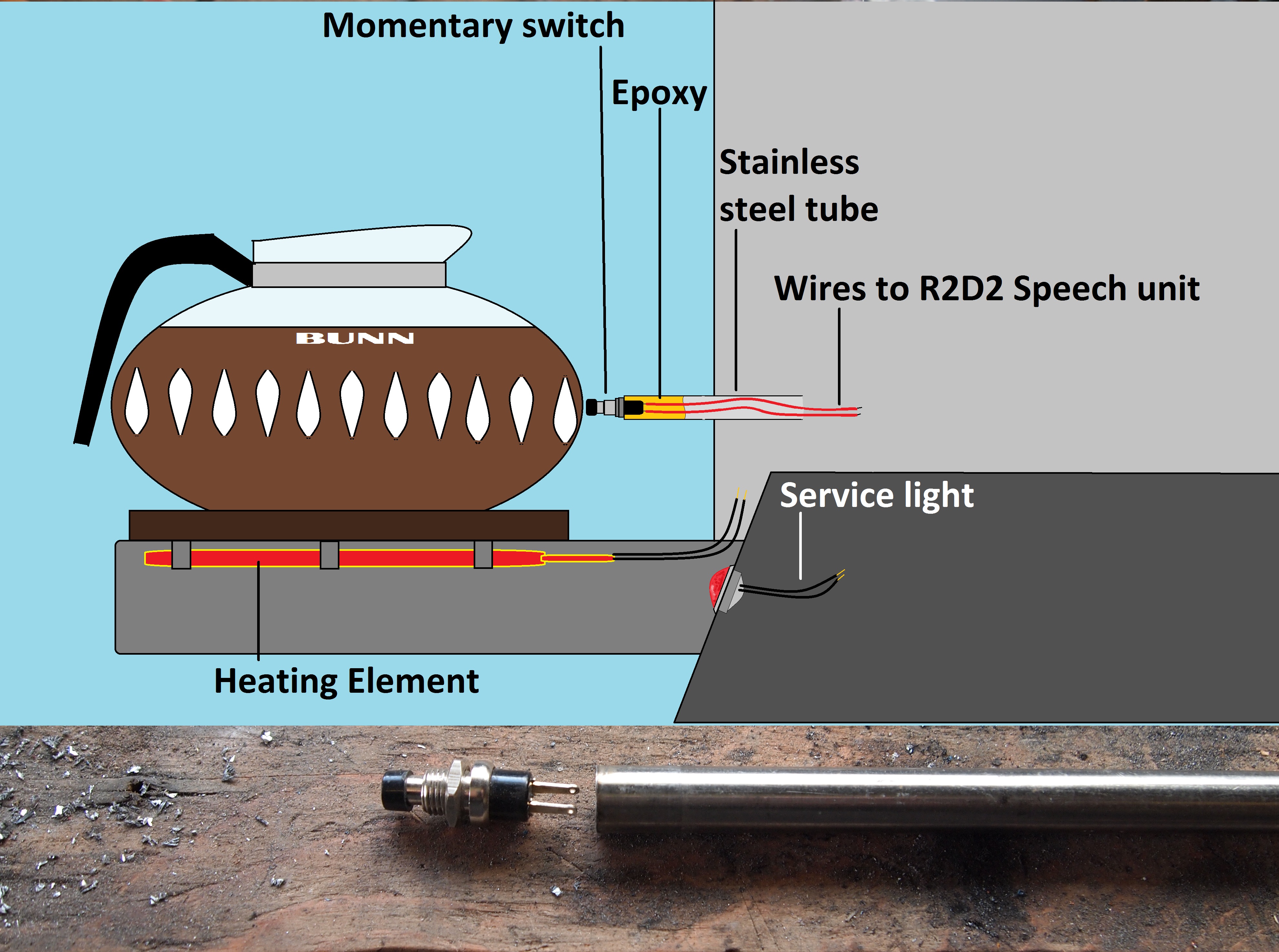

.jpg)
.jpg)
.jpg)
.JPG)
The one I bought for 9.99$ had a musical intro that plays first and gives you the option of recording a P.S. message of 10 seconds long. There are other cards that play longer, purpose built voice recorders you could use or grab a microprocessor like an arduino with a momentary switch and speaker that lets you play back MP3’s, but hacking one of these cards is simple, cheap and available at most drug or grocery stores. The latter, not so much.
The goal of this was to come up with a simple method of recording and playing back classic R2D2 sounds whenever the coffee pot was lifted of its cradle. Having it play for 10 seconds keeps the annoyance factor down, not to mention the sound isn’t going to carry far coming from a little piezo electric speaker.
Watch the video for a breakdown of the components
I attached everything into one of R2`s feet with double sided foam tape just like they`d used in the card. It holds nicely and when I eventually need to change the batteries it won’t be very hard to do so.
Finishing
.JPG)
.JPG)
.JPG)
.JPG)
.JPG)
.JPG)
.JPG)
.JPG)
.JPG)
.JPG)
.JPG)
.JPG)
.JPG)
.JPG)
.JPG)
.JPG)
.JPG)
.JPG)
.JPG)
.JPG)
Now depending on how you made yours will depend on the final order of the build. I have included a basic idea of what I went through to get it all together, this was my “R2-Do List” get it? Oh yeah. Of course this list is based on my insane work schedule, so...
Thursday 4:40am till 5:00 am
1. Remove coffee grinder assembly and other bits to be blued and paint, items such as
a. Mesh Bib
b. Trim
c. Sound switch “washer”
2. Silicone tank seam top and bottom. Also seal around wires for dome light, in and out
3. Fit another led light onto end of coffee strainer or perhaps body to direct light into the coffee ground unit and out eyes
Thursday afternoon – 1:00pm – if possible
4. Cut hole for heating element in lower front of R2’s body
5. Drill 2 holes for heating element plate, tap and test screw fitment, ensure screws can be threaded in and out multiple times
6. Drill and weld a bolt into bottom of coffee unit – will act as a ground point
7. Drill 2 holes in center of base.
a. Align body to base and weld through the holes locking down the body
b. Or – continue drilling through and bolt in place
8. Cut slits in dome ring to accommodate rivets in top of body
Friday afternoon – 1:00 till 3:00 – if possible
9. Drill holes through tops of inside shoulder just off center towards the back of centerline and through the body where they meet. Drill 1 hole through inside of one leg at cantilever level and mating hole on body
10. Weld legs to feet
11. Drill and rivet tops of shoulders to body
12. Cut trim piece to cover gap on back of temp control unit and rivet in place
13. Fit bib – drill holes through bib and into body. Bolt in place. Drill hole for sound switch, refit bib with switch and place and re-bolt. Check for movement. When secure remove
14. Remove element, switches and light cover
15. Paint and Pray
Saturday morning – 11:30am till ?
16. Fit new wires and new connections, heat shrink what you can
17. Make sure copper down pipe is secure
18. Re-install heater element plate and wires
19. Run cables through legs from feet and into body and terminate at foot switch and foot light. Leave extra cable
20. Install sound system in one foot, feed cable through to body and mount sound switch, glue in place
21. Install transformer in foot, feed cable to tie into dome. Pigtail Transformer to main power
Sunday morning - ?
22. Install blued coffee ground holder
23. Install coffee system wires, temperature controller and join tank to dome. Hook up dome light and lower dome in place keeping an eye on the temperature probe wire. Screw in head screws
24. Paint on finishing touches and allow to dry
25. Paint and fit new black center eye
26. Write an Instructable for it?
About the Paint.
I used a variety of paints for this build. You can see in some of the pictures that the tank is all ready white. The reason for being that I hadn’t really thought the process through and thought I’d save time by pre-painting part of it. This doesn’t really work well though as there was way too much fitting, welding and refitting to be done before painting could begin. So first holes were drilled for the wiring and then the entire unit was welded together. With a little grinding it looked oh-so nice and shiny. I was very tempted not to paint it, as I often am with builds like this. It seems a shame to cover up metal work like this but this was always in the design. I’m sure a carpenter feels the same if he milled ornate crown moulding with no fillers used only flawless process. Then the buyer promptly paints it right in front of him, covering up all his work...
Anyway, the first paint I used was high heat enamel, kinda like a white version of barbeque paint. It looked nice and covered well but was not suited for the job. It scratched off so easy, not something that’s going to hold up well in a busy kitchen. Then I thought of using your typical rust paint like Tremclad or Rustoleum, but decided against it. These rust paints are durable, but they are soft for so long. No I wanted something really tough and available without an environmental permit. Enter, Epoxy appliance paint. Resistant to scratches and chipping, scrubbable and somewhat quick drying. Tremclad would have taken many days to reach a working hardness, the epoxy took 12 hours to get really hard and 24 hours for a diamond cure.
The blue anodize paint is similar to the enamel, weak indeed. Looks great, but scratches easy. I ended up using it anyway, but top coated it with a enamel clear coat. It seems ok, but I guess only time will tell.
Other details, shadows and lines were completed with a combination of a sharpie pen, model paints and I have to admit some of wife and daughters nail polish. Don’t laugh great colours and a nice hard finish. This was clear coated as well
Finally the laser damage! This was easy actually, and not painted on as well, which is why it looks great. Instead I hooked the ground cable of my welder to the frame. Ground the paint off just the very center of where I wanted the laser to strike, and struck an arc dead center. This produces a blast of heat that scores the paint and metal in multiple directions providing the look of blaster damage. Clear coat and Bobs your uncle, in my case he really is! Hey Uncle Bob!
That big beautiful black eye!
Like I said at the beginning of this Instructable, I learned this trick off an astro-droid website. Get yourself a 2 liter pop bottle and empty it of its contents. Coco-cola would be my first choice but there bottle doesn`t work for this. Pepsi brand bottle are perfect. Just before the top of the bottle is the curved shoulder. Cut out a section larger then you need. Then out of this cut a circle ever so slightly larger than the size you need for the black eye, say 2mm larger. Paint the inside curve of the lens with black paint. The convex side will now be a glorious shiny black looking lens with the plastic forever protecting the paint behind it. Now just carefully squeeze it into the hole. At first you will think it won’t fit, but if you use toothpicks as leverage bars the soft plastic will yield and suddenly pop into place. The gap where the metal of the eye piece and the dome meet is never perfectly flush, so the excess plastic of the lens fits in perfectly like a snap ring. If it gets damaged it’s easy enough to poke with a razor blade in the middle and pry it out. Make a fresh one and wiggle the new lens in. I have made about 3 of them so far, not because they were damaged by others, but by me. Often I would want to see what it looked like, forget the lens in, and then do some welding on it or painting. So a new lens was required.
Last minute I decided to make additional trim for the front. I wasn`t going to when I started this project thinking I would just paint it all on. But as it takes very little time to come sheet metal I thought why not. The trim was the section around the sound switch and the vents below the coffee grin holder. Once again, each to his/her own.
Another idea I tried but just didn’t work well was to aim a high intensity LED through the eyes of the coffee grind droid. These red lenses were designed for night viewing only and were designed to have just a faint glow as to not induce night blindness. They even had an option where if you turn the housing an iris would close ½ way and reduce the glow even further. A 1 watt star luxeon LED would barely light them up, and cast an icky glow on the coffee maker behind it, so I ditched that idea. Even tried shinning a laser pointer through them, this made them glow a little but the nature of a laser is to shine one beam. I would need either some kind of a splitter or 3 lasers, bah.
Wire It Up
.JPG)
.JPG)
.JPG)
.JPG)
.JPG)
.JPG)
.JPG)
Grounding the unit is very important; you don’t need to fry yourself in the process of enjoying your coffee. Originally my unit had only one spot where it was grounded. I spoke to one of the electricians I work with about this and he said it should be fine as long as all steel components have a solid connection. I was a little dubious and decided to ground on not only the base of the unit, but also to the tank itself. The point where R2’s dome meets the body should be fine, but I thought better safe than sorry. If you are unsure about this you should have a licensed electrician give a once over. Most electricians will be happy to help, just bring the whole mess to them to have a look at. Haven`t met one yet who will charge for something like this, but you never know. If you’re still worried, only plug the unit into a GFCI plug.
Lastly the LED eye, this may seem like a silly way to power it but it was easy and free. I didn`t bother to use a switch for it as BUNN coffee makers don`t use a switch for the main tank either. So when you plug them in, they are always on. Tying the LED to the tank seemed wise as it would be a reminder that the unit was still plugged in. Now the LED I used is designed to handle 13.5 volts of DC power, or rather its resistor is rated for that. It is actually 2 LEDS, one red and one blue soldered to a teeny circuit board. I pried it out of wind-shield washer spray unit designed to light up the hood of a car. I`m all about recycling, so I used what I had. The coffee maker on the other hand is designed for 120v of AC power, so I couldn’t just hook them together. Instead I took advantage of R2`s big hollow feet. I simply hid a small cell phone charger that converts 120v AC in and outputs 4v DC. Even though the resistor is rated for 13.5v the LEDs themselves only require 3.5v, with the other .5v going to resistor heaven. I simple tied the ac plug section of the small transformer into the power going to the coffee maker. When you plug in the coffee maker, the power splits to light the LED and turn on the coffee maker, unplug it and it the coffeemaker turns off as does the LED
Take It for a Test Brew
.JPG)